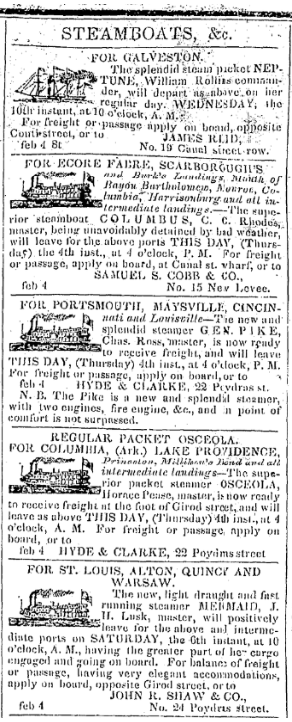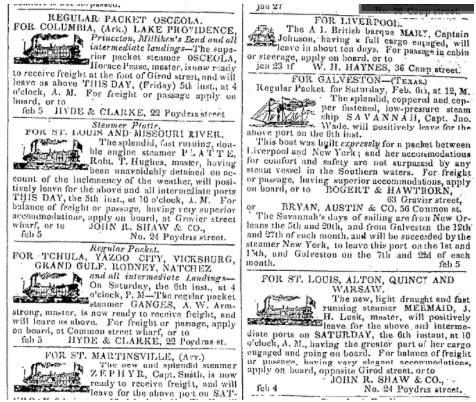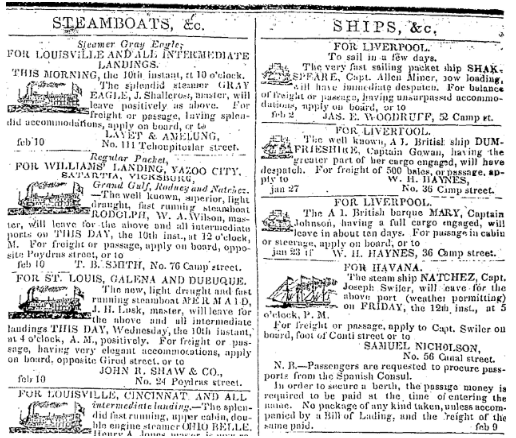The year 1841 in New Orleans brought tremendous amounts of growth and prosperity to the city. The main culprit for this increase in success is the emergence of the steamboat. Prior to this ship, the country sent out keelboats and flatboats as means of transporting goods. The incredible steamboat, New Orleans, first set out on October 20, 1811, on a 1,800 mile trip. This voyage took the boat through the Ohio and Mississippi Rivers, proving that it had the durability to handle the country’s longest and toughest trip. The arrival of this boat channeled the significant growth that was nearing emergence. This journey was funded by Robert Fulton and Robert Livingston, the first two men to realize the immense potential the steamboat had to offer America’s waters. In fact, the United States, specifically New Orleans, is forever appreciative of this invention, as their economy boosted colossal amounts during this time period. With the economic shift due to the ever-expanding New Orleans port, race relations in 1841 were changing dramatically. This steamboat created a new life for black workers, allowing them to stray away from intense slave labor. The steamboat should not only be appreciated for creating economic profit for the city, but also because it instilled hope in black river workers.
Due to the economic failures that spurred widespread fear throughout New Orleans in the years prior to 1841, the advent of port and sea commerce allowed their economy to flourish once again. There were many economic crises leading up to 1841, such as the removal of deposits from the Second Bank of the United States and the Panic of 1837. Because of this, New Orleans needed an asset that would help their economy build back up again. New Orleans looked to foreign trade markets in order to do so. As mentioned previously, the profit in New Orleans due to the port was unlike anything in the United States at the time. In fact, New Orleans became both the wealthiest and third largest city in the country in the

Names of steamboats leaving the port; Photo by Times-Picayune
1800’s. Additionally, New Orleans was deemed the leading export city with one of the top ports in the country. Their foreign export and imports proved to be more successful than their domestic ones. In fact, the city was shipping the majority of the nation’s exports to places such as South America, Europe, and the Caribbean. However, cotton was among New Orleans’ most valuable resources as they exported to both foreign and domestic markets. Thomas Redard, author of The Port of New Orleans: an Economic History, explains the boom in river commerce as produce “surged from $49,822,115 in 1840-41 to $196,924,083 in 1850-51, an unprecedented level” (173). In fact, in nearly every article of the February Times-Picayune in 1841, there are announcements of the steamboats headed out for sail. It is fascinating and incredible that something as simple as the steamboat and the geographical location of New Orleans are the reasons for success unlike ever before. Without utilizing the port, the economy of New Orleans would never have been met with as much success as it did.

Names of steamboats leaving the port; Photo by Times-Picayune
While the steamboat was making incredible strides in New Orleans, free black river workers were feeling the same positive effects. On the river, these workers were treated vastly differently as compared to slaves. Author of Rascals on the Antebellum Mississippi: African American Steamboat Workers and the St. Louis Hanging of 1841, Thomas Buchanan, writes “Black river workers were esteemed in port communities and became an ideal of manhood for young black boys. These boys often looked to the river as a place of hope and opportunity” (801). In fact, Charles Brown, a boat worker himself, used his connections in order to aid fugitive slaves to become steamboat river workers themselves. Among him were many other brave and selfless workers dedicating their time to helping others escape the confines of slavery. He goes on to illustrate, “The proliferation of steamboats on the Mississippi River system… gave southern merchants and planters opportunities for considerable profits but also created a mobile class of slaves and free blacks that moved with ease through the economic arteries of the southern economy” (798). On the river, material gain was possible and talents were welcomed and rewarded. Buchanan further explains how these men avoided “honest labor” and found loopholes in the weakness of the slave economy. While both the economy, as well as black river workers, were prospering exponentially in 1841 New Orleans, slaveholders were facing a myriad of issues as slaves were being taken from them for work on steamboats.

Names of steamboats leaving the port; Photo by Times-Picayune
Ultimately, the steamboat and port of New Orleans permanently changed this city in 1841 and the years surrounding it. The thriving economy New Orleans was experiencing at this time directly parallels the success of these black river workers. 1841 is a time period that New Orleans will never forget, as it peaked economically and achieved greater happiness for black river workers.
Works Cited
Buchanan, Thomas C. “Rascals on the Antebellum Mississippi: African American Steamboat
Workers and the St. Louis Hanging of 1841.” Journal of Social History, vol. 34, no. 4,
2001, pp. 797–816. JSTOR, www.jstor.org/stable/3789419. Accessed 19 Apr. 2021.
History.com Editors. “New Orleans.” History.com, A&E Television Networks, 5 Apr. 2010, www.history.com/topics/us-states/new-orleans.
“New Orleans (Steamboat).” Wikipedia, Wikimedia Foundation, 11 Jan. 2021, en.wikipedia.org/wiki/New_Orleans_(steamboat).
Przybylek, Leslie. The Incredible Journey of the Steamboat New Orleans: Blog. 18 Oct. 2017, www.heinzhistorycenter.org/blog/western-pennsylvania-history/the-incredible-journey-of-the-steamboat-new-orleans.
Redard, Thomas E., “The Port of New Orleans: an Economic History, 1821-1860. (Volumes I and II) (Trade, Commerce, Slaves, Louisiana).” (1985). LSU Historical Dissertations and Theses. 4151.https://digitalcommons.lsu.edu/gradschool_disstheses/4151
Winston, James E. “Notes on the Economic History of New Orleans, 1803-1836.”
The Mississippi Valley Historical Review, vol. 11, no. 2, 1924, pp. 200–226. JSTOR,
www.jstor.org/stable/1893582. Accessed 19 Apr. 2021.
This piece was edited by Ethan Meisler as part of Professor Kelley Crawford’s Digital Civic Engagement course at Tulane University.
 NOLAbeings
Multimedia artist Claire Bangser created NOLAbeings as a portrait-based story project that marries...
NOLAbeings
Multimedia artist Claire Bangser created NOLAbeings as a portrait-based story project that marries...
 Data corner: Adobe Suite (create a PDF, social media graphic, presentation, edit a photo and video
Data corner is where you go to work with analytics and top tech skills. It takes on everything from PERL and SQL to Canva and Sprout Social.
Data corner: Adobe Suite (create a PDF, social media graphic, presentation, edit a photo and video
Data corner is where you go to work with analytics and top tech skills. It takes on everything from PERL and SQL to Canva and Sprout Social.
